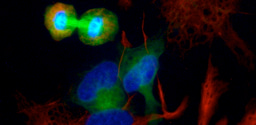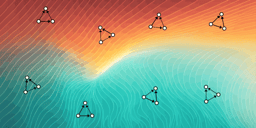A novel Nav1.5-dependent feedback mechanism driving glycolytic acidification in breast cancer metastasis
Published in Cancer
Why we worked on this:
Tumours have an abnormal distribution of H+ and Na+
Cancer cells utilise a large amount of carbohydrates because they preferentially use inefficient glycolytic metabolism to produce ATP even in the presence of adequate oxygen. The reason for this metabolic alteration is not known. One consequence of this is a build up of lactic acid in tumours, which lowers the extracellular pH, and this in turn aids cancer cells to evade attack by the immune system and invade into healthy tissue. Another unusual but less well-known feature of the ionic tumour microenvironment is an increase in Na+ concentration. Whereas protons accumulate extracellularly, the increase in Na+ appears to be in the intracellular space. Again, the cause of this derangement of the normal physiological state is not understood.
Na+ channel activity in cancer and link to metabolism?
For some years a few cancer research groups have been studying voltage-gated Na+ channels normally found in muscle cells or neurons and have shown that these Na+ channels are abnormally highly expressed in many different types of carcinoma cell lines. The presence and activity of these channels increases the invasive capability of cancer cells, and there is evidence that the channels are functionally active at steady state, allowing a persistent inward leak of Na+. This excess Na+ influx must be matched by an increase in Na+ pump activity or cells would rapidly apoptose due to high intracellular NaCl and cell swelling. The Na+ pump consumes a large proportion of a normal cell’s ATP production, and previous evidence has shown that this pump’s ATP demand is satisfied mostly by glycolysis, even in non-cancerous tissues. Therefore, an increase in Na+ pump activity could have a substantial effect on metabolism. We hypothesised that voltage-gated Na+ channels (and other ion channels which allow Na+ to enter the cell) might be at least partly responsible for the large demand for glycolytic ATP production.
What we did:
We showed the clinical significance of voltage-gated Na+ channels in breast cancer patients
Firstly, we wanted to know if the main voltage-gated Na+ channel found in breast cancer, Nav1.5, was prognostically important in breast cancer patients, as previously it had only been studied in cell lines and a small number of patient samples (Fraser et al., 2005). We examined protein expression of Nav1.5 in a cohort of 1740 primary breast tumours on a tissue microarray. We were then given anonymous clinical information about the patients, so we were able to determine associations between these and Nav1.5 expression. We found that Nav1.5 expression is associated with reduced survival and increased metastasis in breast cancer patients. It is also an independent prognostic indicator comparable to tumour size, grade and lymph node positivity. Secondly, we obtained samples of primary breast cancer tumours and cells isolated from primary breast cancer tumours and looked for electrophysiological evidence of Na+ currents through these channels. We were able to record these currents in a few of the samples, although we were challenged by the difficulties in keeping these samples viable enough for electrophysiological recording.
We showed that Nav1.5 presence leads to gene expression changes linked to invasion in breast cancer
We then wanted to know if artificially altering expression of Nav1.5 changed the behaviour of breast cancer. We used a mouse model with a human breast cancer cell line to assess the differences in gene expression with and without Nav1.5 present in the cancer cells. We compared the differentially expressed genes from this experiment with published genes that are differentially expressed between non-invasive breast tumours and invasive breast cancer.
We showed that Na+ influx increases the rate of Na+ pump activity and the rate of glycolysis, but it does not increase the rate of oxidative respiration.
To delve deeper into the mechanism of action of Nav1.5 in breast cancer, we tested our hypothesis that Na+ influx through Nav1.5 channels increases the activity of Na+ pumps, thereby increasing demand for ATP from glycolysis. As this is a multi-step process, we had to test this with a lot of different experiments:
- We assessed the effect of blocking Nav5 on glycolytic rate and oxygen consumption rate in a Seahorse analyser in two breast cancer cell lines, one of which expresses Nav1.5. We found that blocking Nav1.5 does not affect oxygen consumption, but it reduces glycolysis in the cell line expressing Nav1.5.
- We found that blocking glycolysis in two breast cancer cell lines stops the Na+ pump from functioning. The subsequent increase in intracellular Na+ concentration was measured using a ratiometric Na+ indicator dye. Notably, blocking oxidative phosphorylation had no effect on Na+ pump function.
- We found that pharmacologically opening Nav5 channels in breast cancer cells increases Na+pump activity. This was assessed by measuring ATP levels.
We showed that the pH is reduced in highly proliferative areas of the tumour
We measured pH using ion-sensitive microelectrodes in freshly prepared tissue slices from mouse xenograft tumours, assessing both the core and peripheral regions. The tissue slices were then sectioned, and cellularity, proliferation and apoptosis rates were determined by immunohistochemistry.
We showed that reduced pH increases Na+ influx through Nav1.5 channels
Decreasing the extracellular pH to the level reported in tumours (pH 6.2) greatly increased the steady-state flow of Na+ through Nav1.5 channels in cancer cells. This was measured using whole cell patch clamp electrophysiology.
What this research means
We have shown that the voltage-gated Na+ channel Nav1.5 is a negative prognostic indicator in breast cancer, where it is associated with increased metastasis. The channel is functionally active in breast cancer tissue and is associated with gene expression changes related to increased invasiveness. Together with our recent retrospective study of improved cancer outcomes in patients taking voltage-gated Na+ channel inhibitors for other indications (Fairhurst et al., 2023), this strongly supports a clinical trial to test the repurposing of existing voltage-gated Na+ channel inhibitors for use in breast cancer patients.
Our mechanistic work shows a previously unknown link between Na+ homeostasis and metabolism in breast cancer. There is a positive feedback mechanism whereby Na+ channel activity increases glycolysis and reduces extracellular pH, and low pH in turn increases Na+ channel activity. This positive feedback cycle is at its most active in the metabolically active, proliferating edges of the tumour where it aids invasion of cancer cells into surrounding tissue.
References
Fairhurst C, Martin F, Watt I, Bland M, Doran T & Brackenbury WJ. (2023). Sodium channel-inhibiting drugs and cancer-specific survival: a population-based study of electronic primary care data. BMJ Open 13, e064376.
Fraser SP, Diss JK, Chioni AM, Mycielska ME, Pan H, Yamaci RF, Pani F, Siwy Z, Krasowska M, Grzywna Z, Brackenbury WJ, Theodorou D, Koyuturk M, Kaya H, Battaloglu E, De Bella MT, Slade MJ, Tolhurst R, Palmieri C, Jiang J, Latchman DS, Coombes RC & Djamgoz MB. (2005). Voltage-gated sodium channel expression and potentiation of human breast cancer metastasis. Clin Cancer Res 11, 5381-5389.
Follow the Topic
-
Oncogene

This journal aims to make substantial advances in our knowledge of processes that contribute to cancer by publishing outstanding research.





Please sign in or register for FREE
If you are a registered user on Research Communities by Springer Nature, please sign in